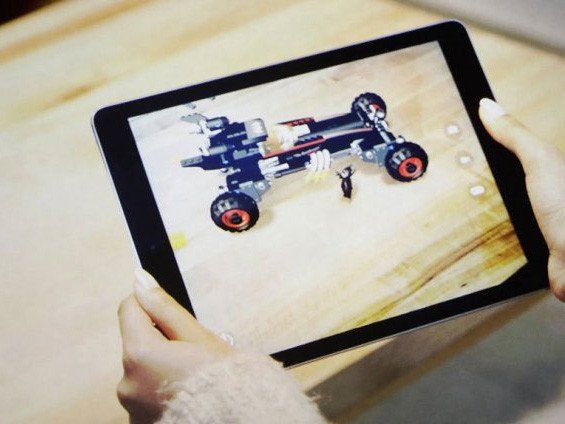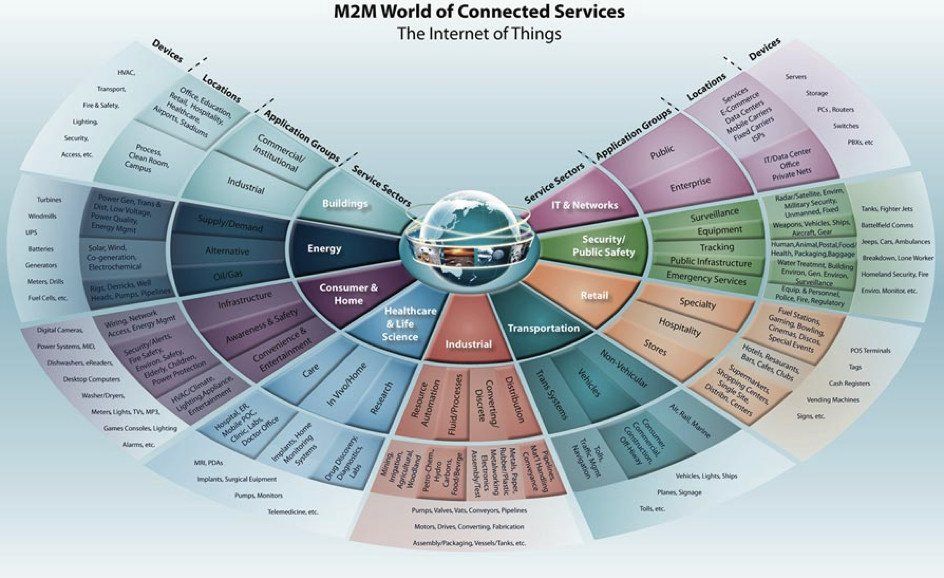How Augmented Reality Drives the Internet of Things
Dirk Schart • September 10, 2019

It is a pretty familiar scene, that of the classic morning routine of the future. A person wakes up, gets out of bed, and walks over to their window. As they gaze out at their city skyline, a hologram hovering somewhere in the sky informs them of the weather. Other floating projections display the morning news, their itinerary for the day, and whatever else may be relevant to that person at that time.
After updating themselves sufficiently, they head over to their closet and virtually try on a few different outfits in a matter of seconds, finally settling on one they are happy with. As they continue to prepare for the day, all the mundane necessities which humans previously had to do manually now operate automatically, leaving the person more time to do something of importance before they embark out the door.
Anyone who has seen more than a few science fiction movies can attest to the frequency in which a scene such as this starts off a film, setting the tone for the viewer that this is a world far more advanced than our own. And while the average person might still believe this type of world only exists in some far off future, those in the tech industry know we are far closer than most would imagine. In fact, as the powerful concept of the Internet of Things continues to establish itself as the definitive topic of discussion and enquiry among the tech world, we may very well be on the cusp of such a world becoming a reality.
IOT CARS AND SELFIE FRIDGES
The Internet of Things is an idea which is quite simple in its essence, but extremely complicated when one delves into the details. The main idea of IoT is this: eventually, every physical object in our world which exhibits any sort of variation or movement will be connected to the Internet. This will allow physical objects to transmit and receive information, permitting their normal affairs and maintenance to run automatically. This in turn would increase the efficiency and reduce the time needed, cost, and errors of virtually every occurrence and event in our modern world. Sounds nice, doesn’t it?New Paragraph
For those that are still confused, imagine a highway where every car on the road is digitally communicating with every other car, constantly updating their current location to ensure that there is never a single accident. Elon Musk's Tesla is following that approach with the so called <a href="https://blogmitcnc.org/2014/08/21/the-tesla-iot-car-case-study/">IoT car</a>. Or imagine a refrigerator that knows when it is out of lunchmeat and automatically notifies a grocery delivery service that it will need more by noon the next day. Industry giant Bosch made the first step in their Home Connect
program with a refrigerator that takes selfies of its contents. In the next step that will be combined with an Augmented Reality app.
CONNECTED WORLD
These are just a couple of everyday scenarios illustrating the unlimited potential of a worldwide connection between the physical universe and the Internet. And while they undoubtedly sound futuristic, the numbers show that our world is irreversibly heading in the direction of connection. Last year alone, an estimated $698.6 billion dollars was spent by businesses on the Internet of Things. By 2019, this number is expected to reach upwards of $1.3 trillion. According to Cisco’s Trend Report, the amount of connected devices exceeded the amount of connected people in the year 2008. Currently the number of connected devices stands at around 13.4 billion, and is expected to reach somewhere between 30 and 50 billion by the year 2020. These numbers are outstanding, and although 87% of consumers still haven’t heard the term Internet of Things yet, they represent a growing tidal wave in the business world which will certainly crash into major markets once circumstances and timing permit.
Considering forecasts, such as GE’s, which predicted the rising presence of connected machines in industry will add as much as 15 trillion dollars to the global GDP over the next 20 years, it is no surprise many businesses are fervently adapting their business models to be harmonious with the Internet of Things. This convergence of machines, data, and analytics is being dubbed the fourth Industrial Revolution, or “Industry 4.0”, and every major Internet company from IBM and Cisco to Google and Microsoft are competing to be the main provider of the platform which makes this convergence possible. The positive effects for businesses constantly connected to their products, customers and manufacturing hardware are quite apparent, including benefits such as increased operational efficiency, faster decision making, better customer relationships, and a larger potential for correspondence between different parts of the company. Ultimately, all these benefits culminate into a “smarter” industry in which every aspect of the supply chain operates with a greater sense of ease and efficiency.
BECOMING "IOT READY"
There are essentially four different elements of the IoT process which companies must incorporate into their infrastructure to truly achieve the status of an “Industry 4.0” company.
1. Implementation of “connectedness” capabilities
This is done by implanting sensors, processors, or any other technologies which allow data to be exchanged between the product and its environment. In support of their IoT platform, Bosch Software Innovations advertises that in 2013 they shipped out more than one billion of their MEMS sensors which are designed with this type of information exchange in mind. Bosch also has the upper-hand in this area since they are already a leading manufacturer of electronic products.
2. Cloud computing and platform systems
Cloud systems can store the flow of data and allow for the oversight of the products themselves as well as any applications a company might sell or utilize. In this area, Amazon’s IoT Amazon Web Services platform dominates with cloud capabilities and services which are quoted as being “many times the aggregate size of all other providers in the market.” Our partner Microsoft offers their Universal Windows Platform which allows developing apps cross-device for smartphones, tablets and smart glasses like the HoloLens as well as for the Internet of Things.
3. Structure and analyze the collected data
This is a huge make-it-or-break-it point for an IoT platform since the technology serving this function needs to ensure that not even a speck of data in the sea of information made available goes to waste. Additionally, the technology should be capable of actively making decisions based on its analytics. IBM has attached their artificial intelligence supercomputer, "Watson", to the front of their IoT platform for precisely this reason, "Watson" is also famously known for winning the popular TV trivia show Jeopardy. Nonetheless, usage of AI supercomputers emphasize the fact that by utilizing the network of information within a platform makes it possible to be actively increase a machine's output to the fullest extent.
THE FOURTH ELEMENT: AUGMENTED REALITY
Now, the fourth and final aspect of this process is arguably the key to bringing IoT from the level of a specialized function into a full on industrial transformation of total connectivity. This aspect is the visualization in real-time of all the data which the Internet of Things will have to offer, and the most obvious candidate to make this visualization occur at the level of scalability which industry requires is none other than Augmented Reality.
Some may ask: If the data can be cognitively analyzed by machines, why is it so important that humans are able to visualize it? The answer here is simple. Ultimately, the whole point of the Internet of Things and the technology which goes into making it a reality is to unlock the full capabilities of human potential. The reason virtually every major tech company is becoming so invested in bringing the idea of IoT to life, and the reason why Augmented Reality is so often brought up alongside this concept, is because they understand the unlimited possibilities it will bring to human existence.
Companies need an ecosystem to integrate Augmented Reality into the Internet of Things. Together with our Industry partner Bosch Automotive Service Solutions we made our content authoring platform REFLEKT ONE "IoT Ready". Whether it comes to the visualization of contextual information or showing live data on machines, cars or any other objects, the platform allows to seamless connectivity to existing infrastructures.
With AR, information will be digitally attached to the physical world, waiting for us to access and use it to further develop our goals and ambitions without ever having to turn our attention away from what it is we wish to do. This will allow for uninterrupted workflows, making processes which previously required a constant shift in attention much more natural and intuitive - thus giving us more time to enjoy life.
And while industry is certainly the first branch of society which is beginning to understand the fundamental importance of what this new development in information processing offers, it will not be long before every other aspect of society catches on as well. It is only a matter of time. Even though very little about this field is still to be set in stone, the knowledge that it could change all of our lives certainly has been. And for now, that knowledge is all Augmented Reality experts such as us require to continue to create and innovate in this revolutionary field, steadfastly propelling us all into the future.
Urgency is the missing ingredient that changes the adoption of emerging technologies such as AR, VR or Blockchain. Technology markets are changing as buyers convert from innovation labs to enterprise rollouts and how this transforms the way technology is reshaped to solve greater problems of higher urgency.
How can you get access to almost unlimited knowledge? Why is it essential to meet founders who have done it before? What is that mindset thing everyone is talking about in the Valley? In this article, I will share my experiences about the ‘Learn & Share’ mindset and why it is beneficial to build a business and bring early-stage tech products to the market—with examples from meetings with founders, advisors, and investors. Here’s my background. I am the Chief Marketing Officer and President of REFLEKT Inc., the US entity of the Munich-founded tech startup simplifying industrial maintenance, operations and training with Augmented Reality. I started building our US business out of Sunnyvale in the Bay Area and turned it from zero to a recognized player within one year. In that year, I had the chance to learn from founders and advisors who have built several startups and who understand what it means to fail and learn. These meetings motivated me to share what I have learned and why I believe there is no better place to learn so much in such a short time. How can you learn in the Silicon Valley? One way is to start watching HBO’s Silicon Valley series. Seriously! This way, you don’t even need to come here. Frankly spoken, what Richard & Co. showed in the six seasons about the tech industry is not that far away from reality. If you do make it to the Valley, though, I highly recommend you to book a tour where you get an express ride through one of the big accelerators. Every day at Plug & Play , I see massive groups walking through the building where we have our office. Plug & Play is the biggest accelerator with over 50,000 visitors from 15 different countries per year during the tours and events. Once you see the companies and startups involved, you realize that you don‘t even need to leave your office to build a massive network. The ‘where’ you can learn is one thing. The ‘how’ and ‘why’ you can learn is the fascinating part for me. What is often separates The Valley from other places is the growth mindset. But, the mindset alone doesn’t make a place special—that’s true. There’s much more than the obvious phrase: in the Valley you rather get a “Yes” instead of a “No” when you come up with a crazy idea – which is something I like to do. Here are my three reasons why this area is so interesting and why you can learn faster and more (about the startup and tech world): 1. A very high number of founders, advisors, VCs involved in tech and startups, 2. All accessible within 50 miles between San Francisco and Santa Cruz, 3. People are eager to share their experiences, learnings, and failures.
I always need fresh input — whether it is from books, articles or podcasts. Especially others sharing their learning (and failures) is a great source to grow. Instead of sharing my favorite podcast series, I want to recommend specific episodes which helped me and which I listen to over and over again. For me, an interesting episode is a lot more than just receiving interesting information. What makes the difference is the people in the podcast. That’s why I don’t have too many sources but love podcasts from Danny Fortson, Reid Hoffmann, Jason Lemkin and Andreessen Horowitz (especially the ones from Sonal Chokshi, and with founders like David Ulevitch). 1. David Ulevitch (OpenDNS & a16z): What Time Is It? From Technical to Product to Sales CEO Since the startup (and founder) journey doesn’t go neatly linear from technical to product to sales, tightening one knob (whether engineering or marketing or pricing & packaging) creates slack in one of the other knobs, which demands turning to yet another knob. So how do you know what knob to focus on and when? How do you build the right team for the right play and at the right time? It all depends on “What time is it”: where are you on the journey, and where do you want to go. In this episode, David Ulevitch (in conversation with Sonal Chokshi) shares hard-earned lessons on these top-of-mind questions for founders; as well as advice on other tricky topics, such as pricing and packaging, balancing between product visionary vs. product manager, how to manage your own time (and psychology!) as your company grows, and more. Much of this is based on his own up-and-down, inside-outside, big-small-big-small, long journey as CEO (and CTO) for the company he co-founded, OpenDNS. 2. Dara Khosrowshahi (Uber): How pirates become the navy Early-stage startups are a lot like pirate ships — they need a buccaneering spirit to survive. But every startup needs to shed its pirate nature at some point, and evolve into something more akin to a navy — no less heroic, but more disciplined. Dara Khosrowshahi, as Uber CEO, took on the most extreme pirate-to-navy transition in startup history. Though Uber blitzscaled to become the most valuable startup in the world, it was also notorious for its toxic culture — and Dara turned the company around. His method? Truth-telling and doing the right thing. 3. Michael Birch (Bebo) & Danny Fortson (Sunday Times): The Bebo Billions Michael and Xochi Birch launched Bebo, one of the first social networks. They sold it at the height of the market for $850 million to AOL Time Warner. Two years later, AOL sold it again — for $1. In a two-part podcast, we tell the Bebo story: its extraordinary rise, the fall, and how the Birches made away with the GDP of a small nation. 4. Nick Mehta (Gainsight): Founder Struggles from Imposter Syndrome to Vulnerabilites SaaStr CEO Jason Lemkin sits down with Gainsight CEO Nick Mehta to discuss what it means to be a SaaS leader. What are the day-to-day struggles? The fears and the worries and what it means to be “crushing it” today. 5. Ben Horowitz (A16Z): “Jeff Bezos should be more like Genghis Khan” The Sunday Times’ tech correspondent Danny Fortson brings on Ben Horowitz, co-founder of Andreessen Horowitz, to talk about company culture, the Amazon example, what’s wrong with new Uber, Uber’s old culture, Silicon Valley’s moment, how culture can be a company-killer, on whether capitalism is changing, why there aren’t more outsiders in venture capital, seeing what you don’t have, how lack of diversity creates product problems, and seeing culture early. 6. Don Erwin (Mixmax): The Secrets to Managing a Successful Sales Team How do you manage a sales team when you’re at a company with both Free and Freemium Sales-Driven Segments? What about SMB vs. Enterprise Sales? SaaStr CEO Jason Lemkin sits down with Mixmax’s Head of Revenue Don Erwin to discuss it all. 7. Christopher Lochhead (Play Bigger): Category Creation is the Strategy In this episode, Christopher Lochhead discusses why category creation is the new growth strategy for legendary marketing. Great companies do not focus on incremental growth, rather, they focus on being exponentially different. These leading companies introduce people to new businesses and provide them with new ways of doing things. Lochhead cites different big enterprises as well as small enterprises as an example. Huge companies now started as small when they changed our way of thinking. Companies such as AirBNB, Google, Amazon, Palo Alto Networks, Cisco and Salesforce not only created great products — they created a good company and a great category. 8. Bob Tinker (MobileIron): Finding Go-to-Market Fit in the Enterprise In this episode of the a16z Podcast, Bob Tinker, author of the book Survival to Thrival and founding CEO of MobileIron, and a16z general partner Peter Levine, talk with Hanne Tidnam all about how to find the right go-to-market fit for the enterprise startup. How do founders avoid that moment of reckoning after product-market fit, but before growth? When should an enterprise startup accelerate sales investments? — the “Goldilocks problem” (not too early, not too late!) — and pick the right sales team and go-to-market model for their product and their customers? And if you’re stuck in that moment where growth stalls, what are the right tools to get out of it? What are the important metrics to know both where you are, and when you’re out of the woods? 9. Mark Mader (Smartsheet): Staying Accountable and Scaling a High Growth SaaS Company Learn how Mark Mader grew Smartsheet from a six-employee startup to a publicly traded company with over 1000 employees serving 82,000 customers. How did Mark and his team convince investors and customers that Smartsheet was solving for what spreadsheets don’t do well? Why did Smartsheet host their first customer conference just three years ago? What did Mark look for in new board members heading into Smartsheet’s IPO? Get the answers to these questions and more in this episode. 10. Dirk Schart (RE’FLEKT): Building the AR Operating System for Enterprise In this episode, Alan Smithson and myself are talking about early-stage markets, my experiences from building trust in the enterprise sector and realizing a vision to make a difference in the AR market. Most businesses have the information and infrastructures they need to be more efficient and competitive — it’s just a matter of having it all at their fingertips. RE’FLEKT is working at making that process easier by creating a modular, scalable, open-source operating system for businesses to build their own in-house AR applications on top of. President and CMO Dirk Schart drops in to explain how. Enjoy listening! I hope you take as much from these episodes as I did. Follow me on LinkedIn or Twitter where I share my thoughts around startups, tech, marketing and growth. On our blog you can find more about what we do at RE’FLEKT .

These days, most of the news around Augmented Reality are about Apple and its new ARKit — a development tool to place digital objects into real scenery and display it on iPhones and iPads. Still in its beta version, ARKit has started a second wave of public awareness for AR after the most successful mobile game in history: Pokémon Go. With the consumer market now finally entering the AR world, it is little known that the enterprise sector has already been using the new technology for many years — often in stealth mode with prototypes and proof of concepts as internal apps. This is about to change completely. In this article, I want to share some thoughts about how “consumer first” announcements like the ARKit influence the enterprise business. You may think that apps like Pokémon Go and all the examples developed by nerds around the globe with the ARKit don’t have anything to do with the business sector. The same applies to Snap’s Spectacles — AR glasses that look like hipster sunglasses — or Pokémon Go, another mobile game with some hype for AR. Believe it or not: you’ll see all of this repeated in some form or another in the enterprise sector. I’m not talking about single use-case scenarios, I’m talking about how the tools from Apple as well as the AR activities from Facebook, Google and Snap inspire us to rethink the use of AR. These are the opportunities that make better enterprise applications and adapt the technology to the user — instead of educating the user to adapt to the technology. ARKit brings Augmented Reality to millions of users and developers Mapping our world with the smartphone camera and using tracking methods, like SLAM, to place virtual objects into real scenery — in a nutshell… this is exactly what the ARKit does. The more realistic the objects look, the better they merge with the real environment. Once our brain perceives the virtual content like physical objects we reach the full potential of an augmented or extended reality. Therefore the size of the objects has to fit to the environment and the objects have to react to different light conditions — just to mention two important factors. One of Apple’s first applications on iOS is in development with IKEA. It allows IKEA app users place furniture and accessories straight out of the catalogue directly into your living room using Augmented Reality. Apple’s camera and software technology supports what I described before: it identifies the room size and light conditions to scale the furniture to the right size and texture. Imagine this for planning stores, supermarkets, hotels and real estate. This powerful software is giving almost anyone the possibility to create AR applications and will have a huge impact: from September on — with the release of iOS 11 — there will be millions of new AR users and developers building apps. In the first step, we’ll see a bunch of different apps. Once the developers understand the way AR works and what the possibilities are, there will be more and more daily-use applications. It was the same with the first mobile apps — it took some time to reach the full potential. We will be able to create better and more natural user interfaces and get closer to the point where we use AR in daily business. Instead of simply placing furniture in our living room, we will be able to visualize operational knowledge in the real work environment. What would you say if I told you that there is no difference between Pokémon Go and a maintenance application for a technician? Both applications embed digital objects or information in the real world.



